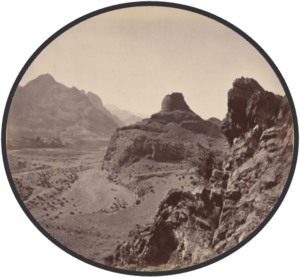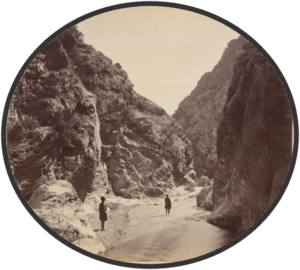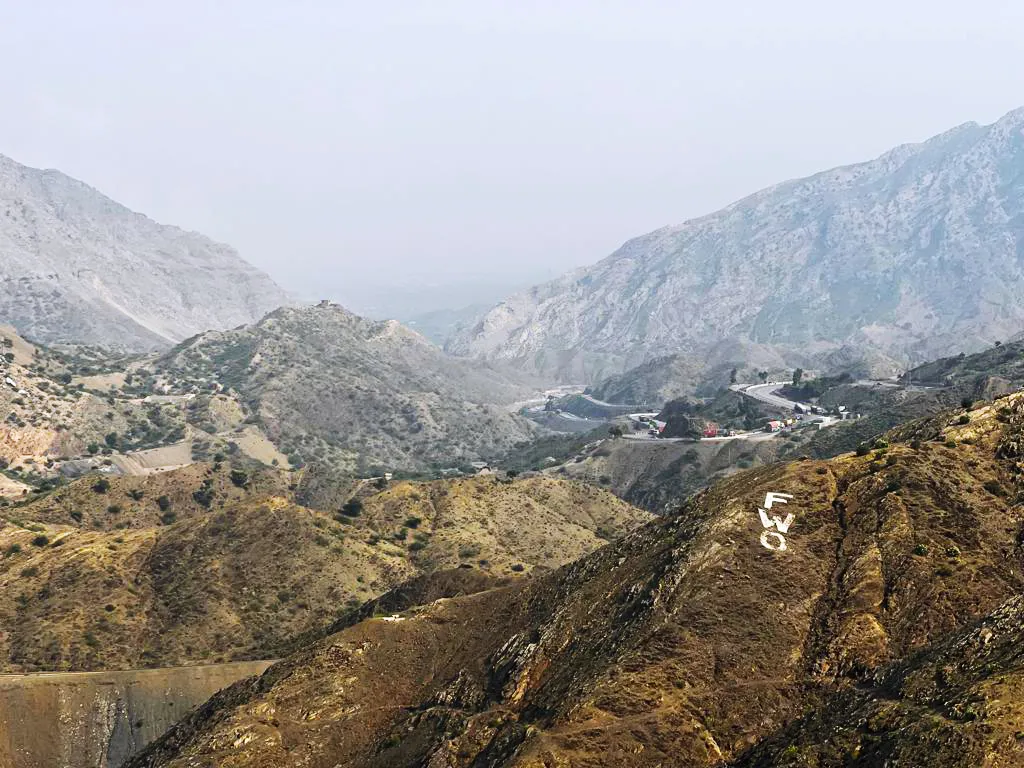The most historic and strategically crucial passage of Khyber Pass is part of Spinghar or Safed Koh mountain range which is a smaller range connected to Hindu Raj mountain range, extending up to Shandur Pass in the northeast while its eastern boundaries is flanked by the Himalayas separated by Indus River. On the western flank lies Shinwar Maidan of lower Kabul valley down to Jalalabad through where flows Kabul River. On the south west lies Parachinar with towering Sikaram Mountain (4755m) Alizai, Shalozan and upper Khyber Hills. The southwestern part is wooded while in the vicinities of Khyber Pass lot of tree cutting, resulting in the deforestation of the hills surrounding the pass. Khyber Pass is a Hebrew word for fortress.
“When spring-time flushes the desert grass,
Our kafilas wind through the Khyber Pass.
Lean are the camels but fat the frails,
Light are the purses but heavy the bales,
As the snowbound trade of the North comes down
To the market-square of Peshawur town.”
Rudyard Kipling
The historic significance of Khyber Pass is full of migrations and invasions that have taken place through the heart of this pass. Around 1500 BC Aryan migrations may have happened through this pass being the most lucrative passage opening up to low hills and vast verdant land.. In 5th century BC during the reign of Darius the Great his armies entered the plains of Peshawar Valley which was a rich agriculture land regarded as the bread of the nations. He probably came close to the confluence of Kabul and Indus rivers, asking Scylax of Caryanda, a Greek explorer and writer whom Herodotus calls ‘admiral’ or master of seas to sail down and find the mouth of Indus River. Alexander the Great after entering Nangarhar near Jalalabad, sent his trusted generals Hephaestion and Perdiccas to follow through Khyber Pass while himself took the route of Bajaur to enter Swat Valley. Khyber Pass became part of Mauryan domain after the war between Chandragupta Maurya and King Seleucus Nicator (305-303 BC) resulting in peace treaty surrendering territories up to Kabul Valley.
During Ashoka’s time Buddhism was introduced and flourished through Kabul valley and beyond. Then in early Kushan rule 1st AD many fortresses and stupas were erected through Khyber Pass whose remains we can still find though many have been destroyed by the iconoclastic tendencies of the inhabiting tribes. Kafirkot fortress ruins are still surviving near Torkham border point. Many other rulering dynasties sent their armies through this Pass and notable are Mahmus of Ghazna who defeated the last of the Hindu Shahi ruler Jayapala in 1000 AD and then Sultan Mahmmad Ghri in 1173 opened the way for Muslim conquests of many parts of India. This was followed by many succeeding Afghan ruling class who took their armies through Khyber Pass. Babur the founder of Mughal dynasty passed through Khyber Pass lamenting that in this pass nothing grows nor even a flower. There are signs of 16th century Mughal road still surviving. Afterwards at the end of Mughal rule Sikh Army of Maharajah Ranjit Singh annexed this important route reaching Kabul. The fort in Jamrud at the foot of the Pass was constructed during Sikh Rule. After defeating the Afghan tribal forces in 1836, Sikh General Hari Singh Nalwa decided to construct a fort to counter any future inroads of local tribal armies. Hari Singh Nalwa lost his life in 1837 battling the Afghan Dost Mohmmad’s army since his most of the army was sent in celebration of the marriage of Maharajah Ranjit Singh’s grandson Naunihal Singh. Hari Singh Nalwa desperately asked for re-enforcements though did arrive and retook the territory falling to Sikhs. He was cremated inside the fortress.


After the fall of Sikhs in Punjab, British finally made themselves masters of the land. Then a new era of wars started resulting in Anglo Afghan wars. The growing animosities between the British and the Russian Empires had triggered a new wave of confrontation between the two powerful forces in the world. British got weary of Russian Empire’s expansionist policies, they had started gradually moving into western Turkestan territories. British earlier had approached the courts of Emir of Bukhara to encounter the expansionist desire of Russians and control over Khiva and Turkmens. Equally knowing the advances of British agents as emissaries to Bukharan court, Russians had started a more aggressive counter campaign.
These were the causes of Anglo-Afghan wars as British needed a safe passage to reach Turkestan which was very difficult to convince the Afghans.
- First Anglo-Afghan War 1838 – 1842 – Result complete annihilation of British army
- Second Anglo – Afghan War 1878 – 1880 – Result British victory
- Skirmishes at Ali Masjid – Khyber Pass
- Third Anglo-Afghan War – 06 May – 08, Aug 1919 – contentious but tactical Victory of British
- Treaty of Rawalpindi – Durand Line Agreed at border
Khyber Pass retains its importance though now the tribal status has been abolished and administrative system comes under the Provincial Govt of Khyber Pakhtunkhwa.



Points of interest in Khyber Pass:
- The Gate of Khyber Pass
- Jamrud Fort – 1836 Sikh period
- The Official view point – see all roads/routes still visible makes it a nice view
- Old Road of Mahmud of Ghazni was improved constructed by Akbat the Mughal – 16th century
- Famous Railway Line – 1920 – 25
- Line is mostly in disrepair and service discontinued owing cost constraints
- Shagai Fort – 1928 – under Khyber Rifles Control
- Buddhist Stupas:
- Ali Masjid Stupa was destroyed
- Ali Masjid (mosque)
- Ali Masjid Fort
- Zintara Stupa in disrepair – only dome visible
- Sphola Stupa was partially damaged but timely action saved it and restored
- The insignias of various regiments served in Khyber Agency from British period to present
- Kafir Kala – Kushan period later under various rulers down to Afghans
Written by: Zia-ul-Haque





